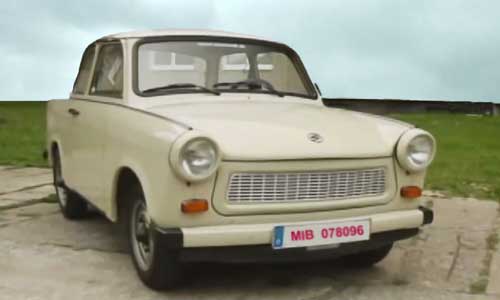The World's Strangest Cars
The biggest! The weirdest! The craziest! Etc etc etc
Click here for cheap UK car insurance!
The trabant - a magnificently awful car
After the fall of the Berlin Wall in 1989 the roads between East and West Germany became littered with abandoned Trabants. Never had a car deteriorated in value so quickly in all of history; a Trabbie could be bought for just a few Deutschmarks, whereas a couple of years earlier a second-hand model could be bought for more than double the price of a new one.
Why were they suddenly so cheap?
Simply; they were a horrible car. Production was in a very old-fashioned factory which was extremely labour-intensive; whilst ambitious production targets were enforced, quality control took second or even third place. The result was that so many of them were just badly put together. This would not have been so disastrous if the basic design was sound, and decent materials were used. Fat chance. It was designed to be cheap transport for the masses in a country with an extremely poor overall standard of living and low wages, and it showed. The materials it was built from were necessarily poor quality, because there was a huge shortage of decent raw materials.
Were the bodies really made of cardboard?
No, this was a capitalist slur on East Germany. In fact their main ingredient was waste cotton. This was bound together with a phenolic resin, creating a plastic called Duroplast. The resin was a byproduct of the East German dye industry and using it in this way was a far better alternative than the normal way of tipping it in a foul smelling, smoking dump which is where so many of their surplus chemicals ended up in those days. Unfortunately Duroplast has proved impossible to recycle; environmental considerations were not high priorities in communist era East Germany.
Did they sell many?
Despite the fact it was a dreadful car it was an overwhelming sales success. The reason for this is that it was the only car available to the vast majority of East Germany's population. Thanks to woeful manufacturing methods, however, production could by no means keep up with demand, and waiting lists between 10 and 13 years were common. Eventually more than 3 1/2 million of these machines were manufactured, but with so many people waiting to buy one their prices on the second-hand market soared.
Were they safe to drive?
They were not safe even when they were stationary. The petrol tank was located over the top of the engine; any leakage or overfilling could easily cause a conflagration, with even the body panels pumping out poisonous fumes as they burned fiercely. In a crash those same body panels fell apart, exposing the occupants to dreadful danger which only seat belts could protect them from. Sadly, none were fitted. The petrol tank was of course one of the first parts of the car to be ruptured in a collision, risking the incineration of both the vehicle, it's occupants and anyone foolish enough to get too close. Having said that most of them drove with the absolute minimum of fuel in them since topping the tank up was very much a hit and miss affair; a fuel gauge wasn't even an optional extra.
Were they environmentally friendly?
Hardly. A Trabant, whether crawling along or chugging down the road at it's maximum speed of 60 mph or so, gave off clouds of smoke which polluted the air and poisoned the lungs of the driver and passengers, local residents and passers-by. This was not helped by the fact that, since there was no oil pump, two-stroke oil had to be added to the fuel at every top-up of the tank, so every drop of oil that went into the car ended up as a polutant.
Was it reliable?
Despite the fact that it's named was inspired by the Russian satellite Sputnik, a technological success, every part of the car was completely out of date. Coupled with equally old-fashioned production methods and an unmotivated workforce it is hardly surprising that breakdowns were very common. The only saving grace of this car is that it was of such a simple construction that repairs were relatively simple to effect, even though they rarely lasted for long.
The original engine was fairly reliable because of this simplicity. If you were happy with a foul smelling DKW two stroke engine of pre-war design, with poor fuel consumption and equally foul performance it would probably be satisfactory. Compared to modern cars with reversing sensors, power assisted steering, entertainment systems, aircon, antilock brakes, electric windows, etc etc, all of which can sometimes go wrong, it was a model of reliability for all the wrong reasons; there were fewer things to go wrong.
Is there still a demand for the Trabant?
The car was so bad that it has now achieved a cult following. However, environmental laws are getting tighter and tighter throughout the world and it is highly debatable how much longer these polluting devices will be allowed to befoul the atmosphere.
